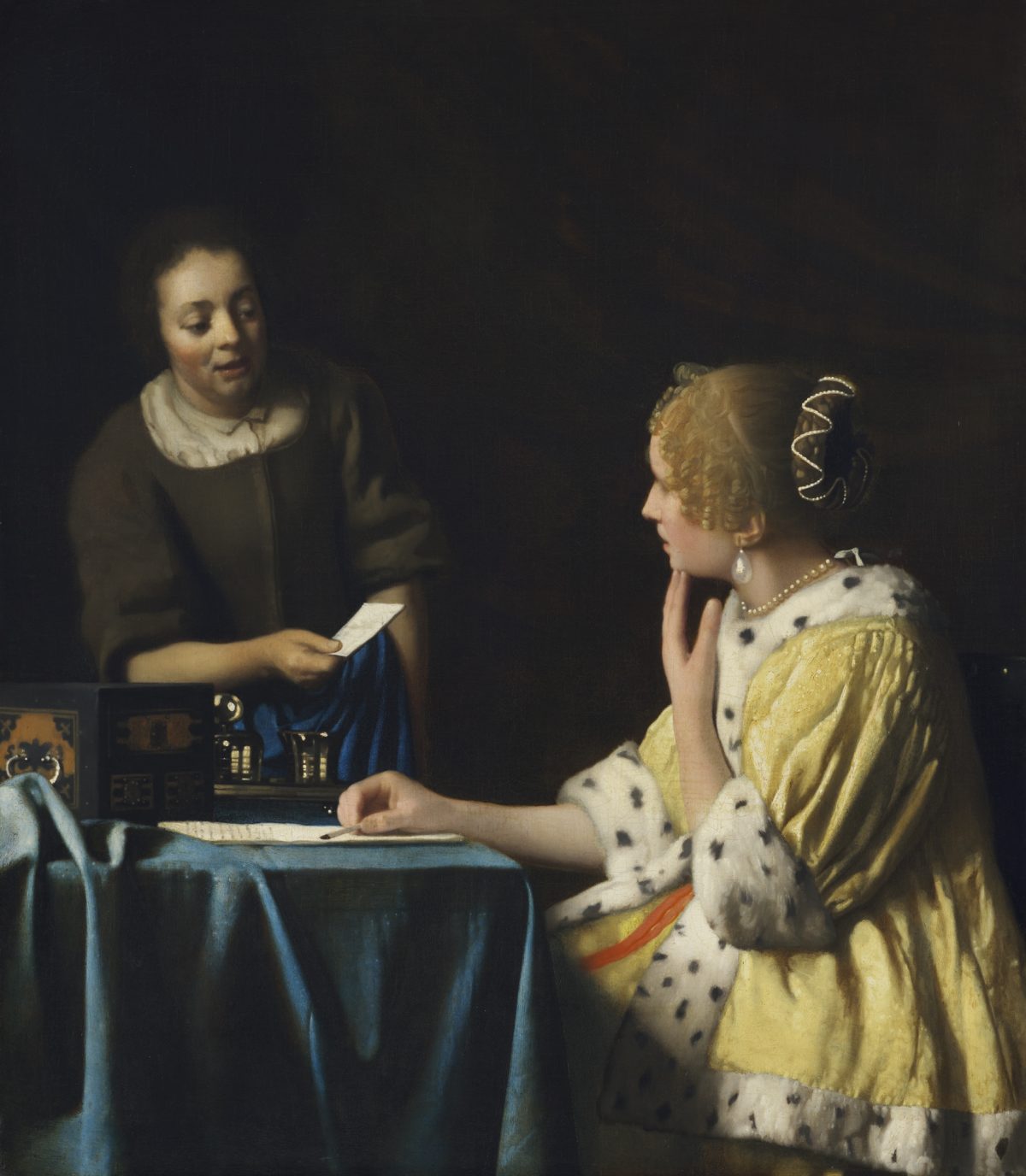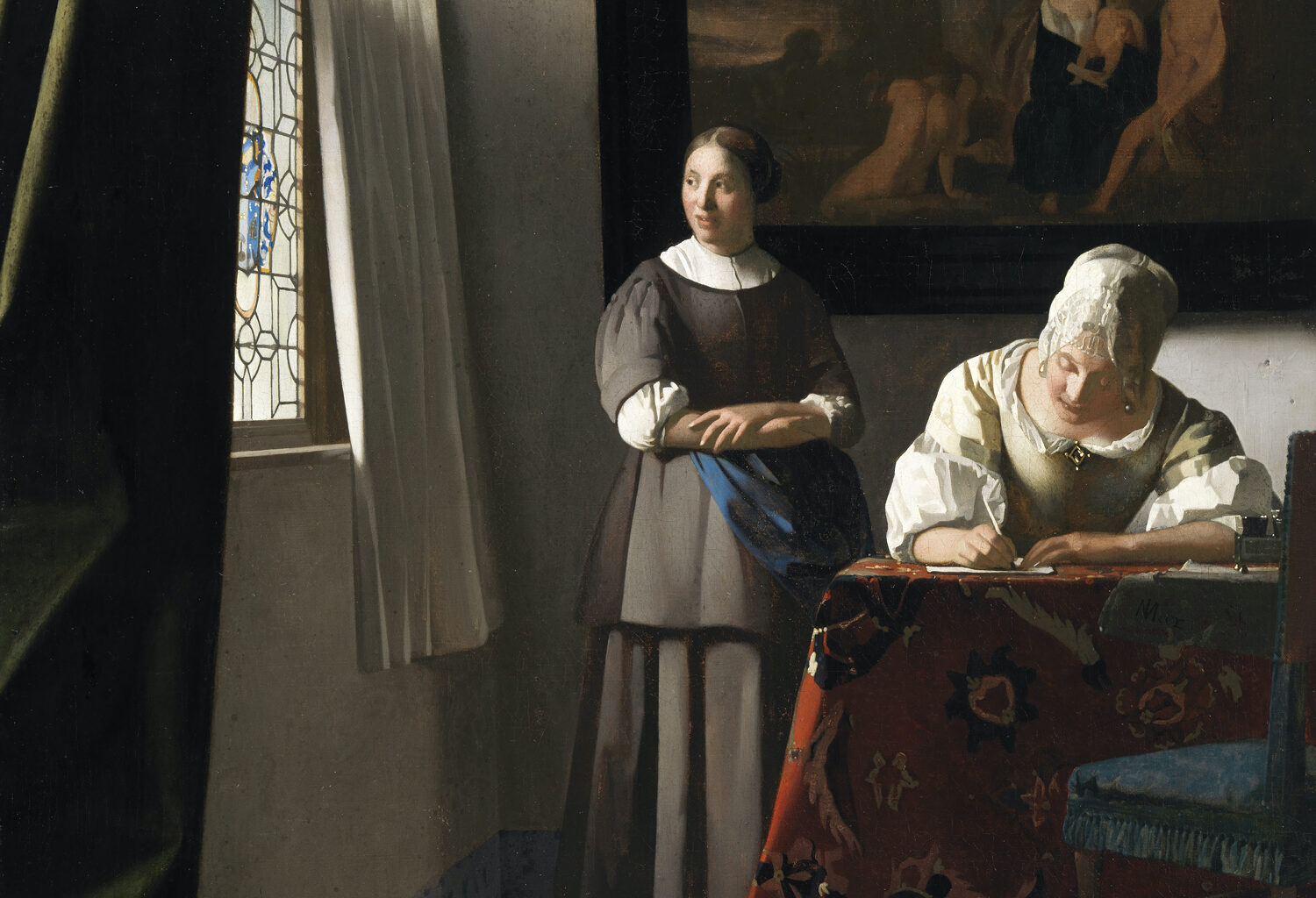Listen up, kids, this is how it worked: When an admirer decided to write to you, they’d take a sheet of paper, inscribe deep thoughts upon it, and mail it. A few days later, an envelope with your name on it would appear in the mailbox, like a gold nugget in a sandy stream bed, among your parents’ ultra-boring mail. The convention was to reply, in order to encourage or deflate. Either way, the letter, now yours, could be saved, shared, dramatically burned, or indifferently tossed.
That was how to slide into someone’s DMs, 1980s style. And 1660s style? Go see Vermeer’s Love Letters, now at The Frick. Mounted to celebrate the renovated building’s reopening, this micro-exhibition displays three of Vermeer’s six paintings that depict women with letters. Each hangs on its own blue-gray, shadow-boxed stele, offset from one another like well-mannered standing stones. And each portrays a lady in the company of a maid, and involved with a letter. Displaying the sum total of the artist’s paintings of the specific motif of a lady, letter, and maid, the show, though small, is exhaustive.
Thanks to recent research, it has become increasingly clear that women played a large role in acquiring paintings in the 17th-century Netherlands, which partly explains their predominance in Vermeer’s work. Two of these painting were particular favorites of the artist’s wife, Catherine Bolnes, who attempted to keep them after his death but was obliged to sell them to feed her many children. They were perhaps a reminder of different days, of youth and flirtation, and the agency afforded to women in the written word.

Johannes Vermeer, “The Love Letter” (c. 1669–70), oil on canvas; Rijksmuseum, Amsterdam, purchased with the support of the Vereniging Rembrandt (press image courtesy the Frick Collection)
Looking at the three paintings together, it’s apparent why the exhibition designers chose to offset the displays from one another: to discourage viewers from bringing strings and pins to create their own crazy walls, tying together shared details and highlighting important differences across the works. For instance, the lap. In the Rijksmuseum painting, “The Love Letter” (c. 1669–70), the woman has been interrupted playing a cittern, a lute-like guitar then associated, like all such instruments, with love and female genitalia. Meanwhile, in the Frick painting, “Mistress and Maid” (c. 1664–67), the subject’s buttery satin yellow dress is trimmed with a vermillion ribbon that lies, not coincidentally, between the fur trim of her jacket lapels, only to be cooled in the oceanic folds of the tablecloth in front of her. In the National Gallery of Ireland canvas, “Woman Writing a Letter with Her Maid” (c. 1670–72) — the only one of the three in which the sitter is actively writing — her lap is taken over by the table, that venue of intellectual productivity and creation.
For another, the maid. Maids and servants in literature of this period were often treated broadly and as comic relief. The maid in “The Love Letter” is the closest to this type — with one arm on her hip, she smiles down on her employer, who appears anxious and uncertain. The one in “Mistress and Maid” obtains the greatest significance. Her cheeks pink with importance, she interrupts her employer, in the midst of writing one letter, to offer her another. This confusing state of affairs brings the lady’s hand up to her chin in a gesture of consternation. Is the new letter from a different suitor? In “Woman Writing a Letter,” the maid, on standby, smiles and looks out the window, allowed a rare moment of interiority.
Lastly, the foreground. Vermeer positions the viewer in “The Love Letter” as if looking into the scene from an adjacent darkened room. The doorway of the viewer’s room frames the painting’s two subjects; as a result, the space on either side of the door divides the composition in three. On the right is a chair piled with rumpled musical scores. On the left is what appears to be a utility cabinet, stained and smeary, its sharply receding perspective tipping the viewer into the colorful sparkle of the central view. Our gaze stumbles over a broom and a pair of shoes just outside the door.

Johannes Vermeer, “Mistress and Maid” (c. 1664–67), oil on canvas; The Frick Collection, New York (© The Frick Collection, photo Joseph Coscia Jr.)
No such obstruction is found in “Mistress and Maid,” which positions us as if seated near the table. Despite their proximity to us, the women seem barely material, their edges dissolving into the black background. “Woman Writing a Letter” presents the women without the obstruction of the Rijksmuseum canvas but deeper in the space than those in the Frick’s. On our side of the table is a blue chair, pulled out as if just abandoned. A sheet of paper, anchored by the inkwell, drapes over the edge of the table into our view, inscribed with Vermeer’s signature. We can sense the artist in the empty chair.
There is much more to consider: The paintings in the background, the different effects of light, the gestures, and the decorative textiles, weighty and nearly animate. To make comparisons outside of the three paintings displayed, the exhibition is accompanied by a handsomely illustrated catalog by the scholar Robert Fucci, which elaborates on the topics of letters, maids, and courtship in the Dutch Republic.
Is the Frick innovating the ideal exhibition format for our new shortened attention span? Perhaps it will help us to better engage with art. Leo Steinberg, art historian and observer extraordinaire, used to recount how he learned how to look at art during the London Blitz of World War II, when the National Gallery of Art would display a single painting, returning it to storage each night. Maybe shows such as this can help us learn to look again. And then write someone a letter about it.
Vermeer’s Love Letters continues at the Frick Collection (1 East 70th Street, Upper East Side, Manhattan) through August 31. The exhibition was curated by Robert Fucci.
Editor’s Note: Hyperallergic’s standard image policy is to run photographs taken by our reviewers to authentically represent their experience. An exception was made in this review due to the venue’s restrictions on photography.
